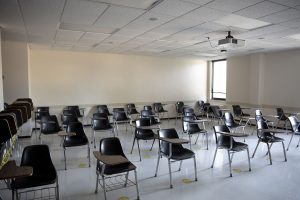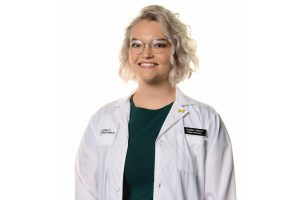University of Iowa researchers’ study on mask mandates ranks among most shared of all time
George Wehby and Wei Lyu’s study over the effectiveness of mask mandates during the early parts of the pandemic has been shared worldwide and have been given a high Altmetric rating
The College of Public Health Building can be seen on Sunday, September 15. The College of Public Health is working with the College of Pharmacy to examine the role of high risk medication in falls in the elderly.
March 18, 2021
Last June, University of Iowa researchers George Wehby and Wei Lyu were some of the first researchers to publish a study analyzing a mask mandate’s effectiveness. Now, their study is one of the most shared studies of all time.
“The Altmetric score of the Lui and Wehby paper (10,127) is unheard of, with 10,350 tweets, 139 citations in less than a year, and 93 percent of tweets coming from the public is extremely rare,” UI Professor of Occupational Health Renee Anthony wrote in an email to The Daily Iowan. “…demonstrating the world’s hunger for understanding what works to protect people around the world.”
Wehby is the John W. Colloton chair in the Department of Health Management and Policy. Wehby said he has worked with Lyu, a graduate research assistant, in the past, collaborating on several different studies.
Wehby said he and Lyu were already working on two other COVID-19 policy research studies — one over shelter-in-place orders and another comparing Iowa and Illinois COVID-19 infections in border counties – when they decided, based on a shared interest in mask mandates, to pursue the study.
“We thought of this policy as another area we wanted to study, so it just came as an additional piece of work – the work we were already doing,” Wehby said.
The study examined data across states of daily COVID-19 infections and how daily infections had changed after statewide mask mandates. Wehby and Lyu said they compared those numbers with states that never released an order.
Specifically, the study finds that “the average daily county-level growth rate decreases by 0.9, 1.1, 1.4, 1.7, and 2.0 percentage points in 1–5, 6–10, 11–15, 16–20, and 21 or more days after signing, respectively.”
The study found that states that adopted mandates in April and early May saw a decline in the growth of COVID-19 cases and advised states not to ease restrictions.
The study made use of public data, Wehby said, and he and Lyu analyzed the numbers. Wehby said the tricky part of the study came from the difficulty of finding measures on all aspects of effectiveness that they were looking into and getting it done in a timely manner.
Anthony wrote that she has worked with Wehby in the past on several committees, but their research usually doesn’t overlap. That changed this past year, she wrote, as everyone was trying to understand COVID-19.
RELATED: Federal order strengthens CAMBUS mask mandate
Data collected from Wehby and Lyu’s mask mandate study has overlapped with her own research over aerosol transport, inhalation, and evaluating respiratory protection effectiveness, she wrote, which pertains to how effective face masks are.
Anthony wrote that research in general – but particularly for the journal she edits, the Journal of Occupational and Environmental Hygiene – has seen a significant increase in readership with studies and archival research related to COVID-19.
Wehby was not shocked at how widely-shared the study became, he said.
“We knew it was a timely topic, an important topic, obviously, really addressing important public health issues,” he said. “So yeah, we anticipated that is going to be well received overall.”
Director of the Health Policy Research Program Peter Damiano, who has been a research colleague of Wehby for over 10 years, said he also wasn’t surprised by how popular the study became, since it was important policy research published in a top tier journal.
Damiano said while the topic was important and timely, he was most impressed by how quickly Wehby and Lyu published the study.
He said being able to accomplish a fast turnaround was important for academic researchers to do whenever possible.
“I think it’s just a great example of academic research that can be done in a very unbiased way, in a timely manner to inform policymakers about some of the most challenging questions that we face,” Damiano said. “George did a very nice job of doing the research and getting it turned around and written up and published quickly.”






